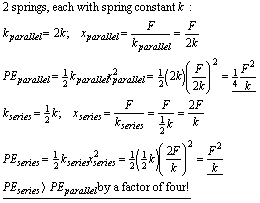
The mass in the figure (all other objects are massless) is raised when the end of the rope is slowly pulled down a distance x.
The force vectors active on the mass (use m), on the end of the rope, and within the rope and bar are shown:
7. The force that must be applied to the end of the rope to keep the mass stationary is F = mg/2.
8. If the end of the rope moves downward a distance, x, at a constant slow speed the force is: F = mg/2.
9. When the rope is pulled down the distance x, (as in 8), the work done on the rope is: (– is down)
10. The force is mg in the bar (dark line) attached to the mass during the motion (as in 8).
11a. The mass moves upward a distance x/2 when the rope is pulled down the distance, x (as in 8).
11b. The work done on the mass by the bar is:
12. The work done on the rope is equal to the work done on the mass by the bar. This is so because: The rope is connected to the bar via pulleys; the forces on the rope and mass are different due to the pulleys, but the work done by the bar on the mass is accomplished by doing the same amount of work on the end of the rope.
13. An ideal spring with spring constant, k , that is stretched a distance, x , from its normal length stores a potential energy of 1/2kx2 . If the spring is compressed by the same distance the stored potential energy is 1/2kx2. The sign of the work done on the spring by the stretching forces is + and by compressing forces is also + .
14. Two springs have spring constants, k1, and k2, and are stretched by distances , x1 and x1, respectively . The ratio of the spring constants to store the same potential is :
15. If I want to store the most energy for a given stretch of the combination I connect the two identical springs in parallel :

16. If I want to store the most energy for a given force applied to the combination I connect two identical springs in series :


17. A spring with spring constant, k , starts with a stretch, x = x0, and is then stretched to a further distance where,
x = 3x0. The potential energy is added (D PE) to the spring during the second stretch is: (express your answer using only k and x0)

